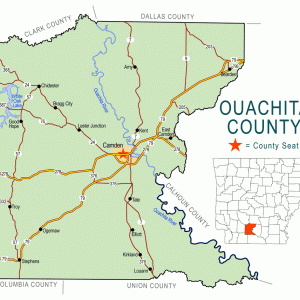calsfoundation@cals.org
Lester (Ouachita County)
Lester (Ouachita County) is an unincorporated community located about six miles northwest of Camden (Ouachita County) and about seven miles southeast of Chidester (Ouachita County). It is also about four miles west of the Ouachita River. The community is also known as Lester Junction.
The Gee family owned land throughout Ouachita County before the Civil War, including two plots of at least eighty acres east of Lester, although they resided in Camden. They were the largest landowners in the area.
Early settlers in the area included Calvin Warren, who obtained 120 acres as part of a federal land patent in 1882. Robert Lester obtained eighty acres in 1888. A post office opened in the community in 1881 and operated until 1948, when operations were consolidated with Chidester.
The economy of the community focused upon two industries: railroad and timber. The St. Louis, Iron Mountain and Southern Railroad constructed a track through the community in 1881. A depot was constructed in Lester, and the site became an important hub for sawmills in the area to ship timber. The community gained its name from John Lester, who owned a home near the depot.
With a rail line established, other businesses began operations in Lester. One of the earliest businesses was a mill built by Joseph Dempsey. Using water from Lester Creek, Dempsey operated both a sawmill and a grist mill. Several sawmills operated in the area, and short line railroads were constructed to bring logs to Lester to be processed. Other businesses included a company owned by Dr. Algernon Garnett, which operated a clay pit and lignite mine about one mile northwest of Lester near Maximo (Ouachita County). Called the Camden Coal, Glass, Clay, and Firebrick Company, the business operated until Garnett’s death in 1919. With the construction of a narrow-gauge railroad, raw materials were shipped to Lester before moving to large-scale industrial manufacturers including Johns Manville and the Pittsburgh Plate Glass Company. Another clay pit, the Bartlett Pit located south of Lester, helped drive the economy with the establishment of a general store, which also housed the post office.
The Lester Saw Mill operated in the community in the early twentieth century. The mill utilized a unique conveyor belt that carried sawdust over the rail line. The company also used a short line railroad to transport logs to the mill. The mill burned in 1910, and the short line railroad was acquired by the Mansfield Hardwood Lumber Company based in Reader (Nevada and Ouachita counties).
Another industry came to Lester in 1909 when the Caddo Oil Company of Shreveport, Louisiana, drilled the first of three wells in the area. While the company found oil in two of the wells, it was not enough to initiate commercial production. The discovery of oil in Union County increased the demand for timber to build oil derricks, and the Lester Saw Mill railroad continued to be used to support those efforts until at least the 1920s.
A local remedy for colds and other ailments began to be manufactured in Lester in the early twentieth century. Called “Bronch-a-tone,” the pink liquid was created by a local chemist named Lilliard who sold it for one dollar per pint. The medicine, which was created using byproducts from lignite production, was used to treat coughs and colds, among other ailments. It did not prove to be successful commercially, and production ceased when the lignite mining stopped.
The Arkansas Dye and Chemical Company had operations in the community during World War II. It is unclear how the company used the raw materials from the area, but locals believed it was either for the production of ink or for a military purpose.
A school operated in Lester in the late nineteenth and early twentieth centuries after the opening of the railroad. It was originally housed in the Lester Methodist Church, and a purpose-built building was constructed for the school at an unknown date. The school consolidated with Fairview (Ouachita County) after World War II.
Mount Willie Church operates in the community. The historically African-American church includes a cemetery with graves dating to at least 1884.
Timber ceased being shipped on the railroad in the 1930s. Passenger service to the community ceased in 1957, and the tracks were removed in 1999. By the early twenty-first century, Lester was serving as a bedroom community for Camden. Much of the land is managed for timber and leased to hunting clubs. The foundations of several buildings at the former site of the Lester Saw Mill Company remain.
For additional information:
“Clay and Coal Mines of Lester/Maximo Area.” Ouachita County Historical Quarterly 19 (June 1988): 19–20.
“Lester.” Ouachita County Historical Society. http://www.ouachitacountyhistoricalsociety.org/uploads/3/4/6/4/34649652/revised_lester_history.pdf (accessed October 16, 2020).
Nunnally, R. H. “Looking Back at the Days of Mining at Maximo in North Ouachita County.” Ouachita County Historical Quarterly 19 (June 1988): 10–14.
Riddick, Benny. “The Entrepreneurs during Boom Days of Maximo’s Mines.” Ouachita County Historical Quarterly 19 (June 1988): 15–18.
David Sesser
Henderson State University
 Ouachita County Map
Ouachita County Map 



Comments
No comments on this entry yet.